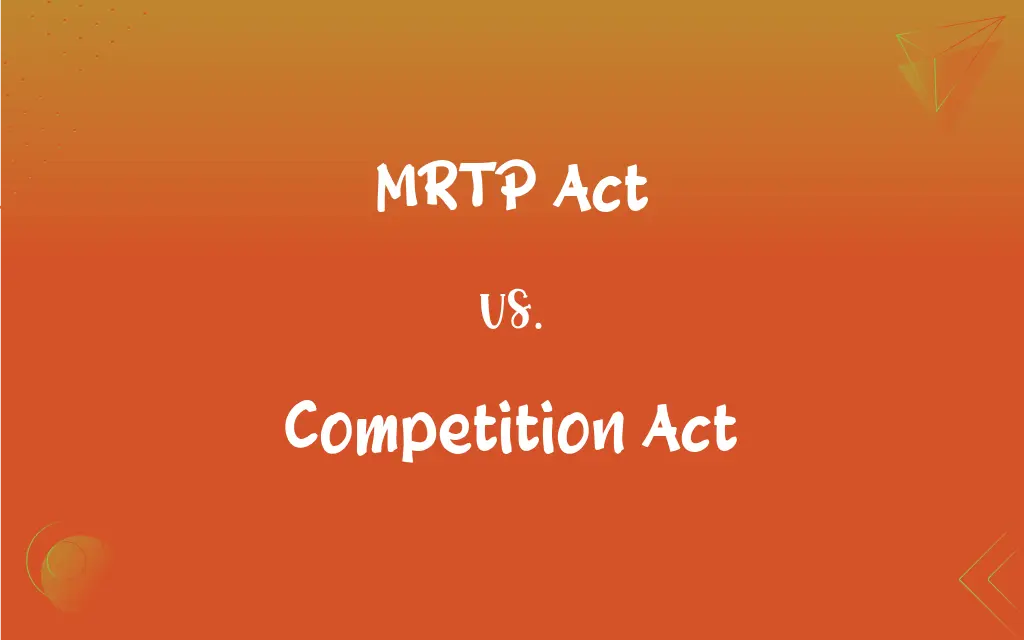MRTP Act vs. Competition Act: What's the Difference?
Edited by Aimie Carlson || By Janet White || Published on February 25, 2024
MRTP Act aimed to prevent monopolistic practices, while the Competition Act focuses on promoting fair competition and preventing anti-competitive practices.

Key Differences
The MRTP Act, or Monopolies and Restrictive Trade Practices Act, introduced in India in 1969, focused primarily on preventing concentration of economic power and monopolistic practices. The Competition Act, enacted in 2002, replaced the MRTP Act, shifting focus to promoting fair competition and preventing practices having adverse effects on competition.
Under the MRTP Act, the emphasis was on curbing monopolies and restrictive trade practices considered harmful to public interest. In contrast, the Competition Act broadens its scope to include regulating anti-competitive agreements, abuse of dominant position, and regulating combinations (mergers and acquisitions) that have a significant impact on competition in India.
The MRTP Act was more reactive, dealing with complaints about monopolies and unfair trade practices after they occurred. The Competition Act, however, is both preventive and reactive, aiming to create a proactive framework to promote fair competition in the market.
Administration under the MRTP Act was handled by the MRTP Commission, which had the power to inquire into and take action against monopolistic practices. The Competition Act established the Competition Commission of India (CCI), with a broader mandate and powers to enforce its provisions.
The MRTP Act did not cover aspects of mergers and acquisitions in detail, which was a significant limitation. The Competition Act addresses this gap by including provisions for the regulation of mergers and acquisitions to prevent any adverse effect on competition.
ADVERTISEMENT
Comparison Chart
Year of Enactment
1969
2002
Main Focus
Preventing concentration of economic power and monopolistic practices
Promoting fair competition and preventing anti-competitive practices
Scope
Monopolies and restrictive trade practices
Anti-competitive agreements, abuse of dominant position, mergers and acquisitions
Enforcement Body
MRTP Commission
Competition Commission of India (CCI)
Coverage of M&A
Limited coverage
Detailed provisions for regulating mergers and acquisitions
ADVERTISEMENT
MRTP Act and Competition Act Definitions
MRTP Act
A regulatory framework to ensure fair trade practices and competition in the market.
The MRTP Act played a crucial role in maintaining market equilibrium during its time.
Competition Act
A comprehensive framework in India to promote fair competition and prevent anti-competitive practices.
The Competition Act facilitated a more competitive environment in the telecommunications sector.
MRTP Act
A legal framework to prevent monopolistic and restrictive trade practices in India.
The MRTP Act was instrumental in breaking down monopolies in several industries in the 1970s.
Competition Act
An act designed to ensure free and fair competition in the market.
The Competition Act has been a key factor in fostering innovation and competitiveness in various industries.
MRTP Act
An act established to protect consumers and small traders from exploitation.
The MRTP Act was used to challenge dominant businesses that were exploiting their market position.
Competition Act
Legislation aiming to regulate anti-competitive agreements and abuse of dominant positions.
Under the Competition Act, several high-profile cases of abuse of market dominance were successfully prosecuted.
MRTP Act
An act aimed at controlling the concentration of economic power to the common detriment.
Under the MRTP Act, companies with large market shares were scrutinized for anti-competitive behavior.
Competition Act
A law that includes provisions to regulate combinations (mergers and acquisitions) affecting competition.
Major mergers in the retail sector were scrutinized under the Competition Act to ensure fair play.
MRTP Act
Legislation focused on curbing monopolies and unfair trade practices.
The MRTP Act led to several investigations into companies accused of monopolistic practices.
Competition Act
An act empowering the Competition Commission of India to enforce its provisions for healthy competition.
The Competition Commission of India, under the Competition Act, took actions against several cartels.
FAQs
Why was the MRTP Act replaced by the Competition Act?
To address modern economic challenges and include comprehensive provisions for promoting competition and regulating combinations.
What powers did the MRTP Commission have?
The MRTP Commission had powers to inquire into and act against monopolistic and restrictive trade practices.
What is the Competition Act?
A law enacted to promote fair competition and prevent practices detrimental to competition in India.
Can the Competition Act address digital monopolies?
Yes, the Act is designed to address monopolies in all sectors, including digital markets.
What was the main objective of the MRTP Act?
To prevent monopolistic and restrictive trade practices detrimental to public interest.
How does the Competition Act regulate mergers and acquisitions?
It includes detailed provisions to prevent mergers and acquisitions that adversely affect competition.
How does the Competition Act benefit consumers?
By promoting fair competition, it ensures better prices, quality, and choices for consumers.
Does the Competition Act provide for penalties?
Yes, it imposes penalties for non-compliance and anti-competitive practices.
How does the Competition Act impact foreign companies in India?
Foreign companies must comply with the Act's provisions regarding competition and mergers in the Indian market.
What is the role of the Competition Commission of India?
The CCI enforces the Competition Act, regulating anti-competitive practices, abuse of dominant position, and mergers and acquisitions.
Did the MRTP Act cover mergers and acquisitions?
It had limited provisions regarding mergers and acquisitions.
Were small traders protected under the MRTP Act?
Yes, one of its objectives was to protect small traders and consumers from exploitation.
Was the MRTP Act effective in curbing monopolies?
It had varying degrees of effectiveness, but faced challenges in adapting to new economic realities.
What was a limitation of the MRTP Act?
Its limited scope in addressing modern economic challenges and lack of detailed provisions for mergers and acquisitions.
Has the Competition Act evolved since its inception?
Yes, it has evolved to keep pace with changing economic conditions and market dynamics.
What kind of practices does the Competition Act prohibit?
It prohibits anti-competitive agreements, abuse of dominant position, and certain types of mergers and acquisitions.
Why is the Competition Act important for market economy?
It ensures a level playing field, essential for the healthy functioning of a market economy.
Can the CCI take suo motu action?
Yes, the CCI has the authority to initiate inquiries on its own accord under the Competition Act.
Was international trade covered under the MRTP Act?
The MRTP Act primarily focused on domestic trade practices.
Can the Competition Act address e-commerce monopolies?
Yes, it can address monopolistic practices in the e-commerce sector.
About Author
Written by
Janet WhiteJanet White has been an esteemed writer and blogger for Difference Wiki. Holding a Master's degree in Science and Medical Journalism from the prestigious Boston University, she has consistently demonstrated her expertise and passion for her field. When she's not immersed in her work, Janet relishes her time exercising, delving into a good book, and cherishing moments with friends and family.
Edited by
Aimie CarlsonAimie Carlson, holding a master's degree in English literature, is a fervent English language enthusiast. She lends her writing talents to Difference Wiki, a prominent website that specializes in comparisons, offering readers insightful analyses that both captivate and inform.
































































